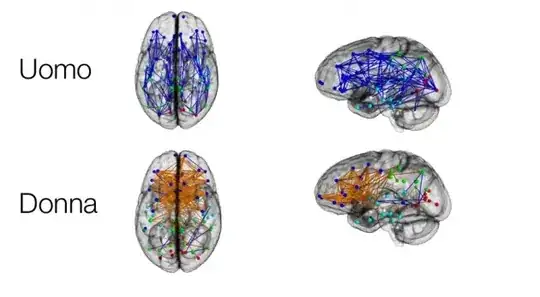Is this image "lying", not showing both types of connections for both genders? The article claims scientific accuracy and to report a scientific paper: does this image represent its conclusions in a fair manner?
Well, it's certainly reporting some of the conclusions correctly. But it's not telling the whole truth.
The article doesn't seem to give the exact name of the study mentioned, but it does name Ragini Verma as leading the study. This supports my original hypothesis that Sex differences in the structural connectome of the human brain is the study cited - Verma is one of the authors.
Quoting from the paper's abstract:
In all supratentorial regions, males had greater within-hemispheric connectivity, as well as enhanced modularity and transitivity, whereas between-hemispheric connectivity and cross-module participation predominated in females. However, this effect was reversed in the cerebellar connections.
This is re-stated later in the paper:
Most supratentorial connections that were stronger in males than females were
intrahemispheric (permutation-tested P < 0.05). In contrast, most supratentorial connections that were stronger in females were interhemispheric. However, in the cerebellum, the opposite pattern prevailed, with males showing stronger connections between the left cerebellar hemisphere and the contralateral cortex.
So the claim is really only supported in one region of the brain, not all regions.
Note the phrasing here. It doesn't say that there are more connections between hemispheres in one gender and more connections inside hemispheres in the other gender, but rather that strength is different. Not necessarily number.
The article only tells half of the truth. Consider it untruthful.
The image, by the way, is from Figure 2 of the paper. The caption reads:
Fig. 2. Connection-wise analysis. (A) Brain networks show increased connectivity in males (Upper) and females (Lower). Analysis on the child (B), adolescent (C), and young adult (D) groups is shown. Intrahemispheric connections are shown in blue, and interhemispheric connections are shown in orange. The depicted edges are those that survived permutation testing at P = 0.05. Node color representations are as follows: light blue, frontal; cyan, temporal; green, parietal; red, occipital; white, subcortical.
GM, gray matter.
Sections B, C, and D are not shown in the article's use of the image.
